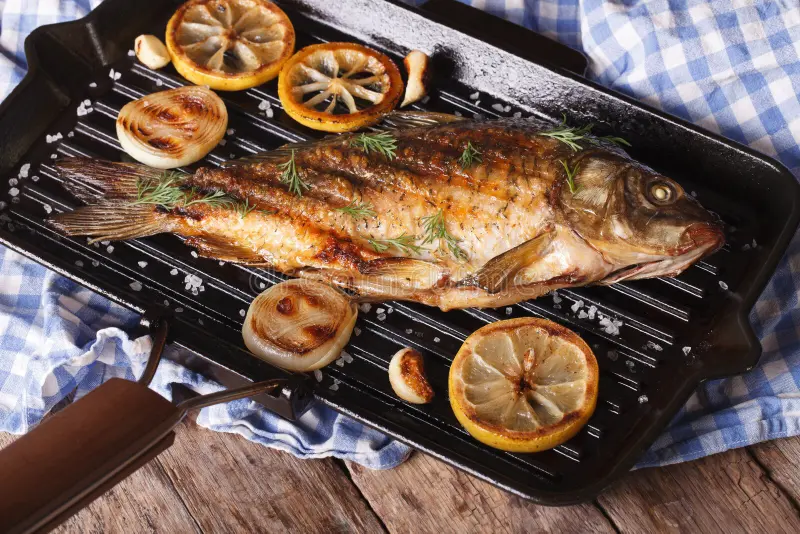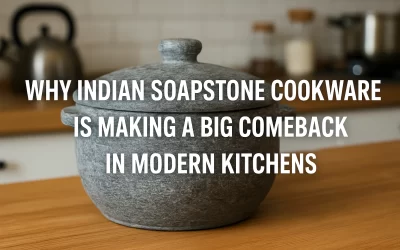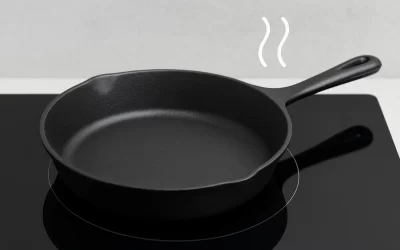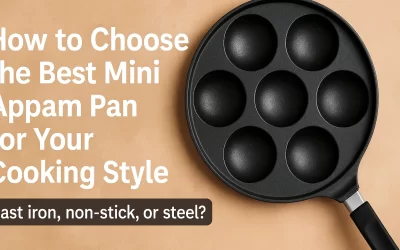Why Frying Fish is a Culinary Skill Worth Mastering

Iron Fish Fry Pan is an art. A perfectly fried fish is crisp on the outside, flaky and tender inside, and packed with mouthwatering flavor. It’s a beloved dish in coastal and inland kitchens alike, cherished for its simplicity and deliciousness.
Tradition and Flavor
Across cultures—from Southern U.S. catfish fries to Indian masala fish—fried fish holds a special place. It’s not just about taste; it’s about bringing family and friends together around a satisfying meal.
Health Benefits of Fish
Fish is an excellent source of lean protein and omega-3 fatty acids. When cooked right, especially in a well-maintained cast iron pan, it retains nutrients while gaining that irresistible crispy finish. buy cast iron cookware online India.
The Advantages of Using Cast Iron for Frying Fish
Cast iron cookware offers unique benefits that make it the ideal choice for fish frying. handmade brass cookware India
Superior Heat Retention
Cast iron holds heat exceptionally well, allowing for even cooking—a must for delicate fish fillets that can easily burn or undercook.
Even Cooking Surface
Cold spots are the enemy of crispy fish. Cast iron ensures the entire surface is evenly heated, producing consistent results.
Non-Toxic and Chemical-Free
Unlike non-stick pans that may leach chemicals at high temperatures, cast iron is a natural, safe, and chemical-free option.
Choosing the Right Cast Iron Skillet or Pan
The right pan can make all the difference.
Skillet vs. Griddle
- Skillet: Best for shallow frying with sides to prevent oil splatter.
- Griddle: Ideal for whole fish or multiple fillets when you want more surface area.
Size and Depth Considerations
Choose a 10–12 inch skillet for versatility. Deeper pans help contain oil and make cleanup easier.
Prepping Your Cast Iron Before Frying
Preparation is key to preventing sticking and ensuring flavor retention.
How to Season Properly
Rub the pan with a high-smoke-point oil (like flaxseed or grapeseed), bake it upside down in the oven at 400°F for 1 hour, and let it cool naturally.
Avoiding Sticky Surfaces
Ensure the pan is thoroughly preheated before adding oil and fish. This forms a temporary non-stick layer.
Selecting the Best Fish for Frying
Top Varieties
- Tilapia: Mild and affordable.
- Catfish: Southern favorite with firm texture.
- Cod: Flaky white flesh that fries beautifully.
Fresh vs. Frozen
Fresh fish is ideal, but if using frozen, thaw completely and pat dry to avoid oil splatter and uneven frying.
Iron Fish Fry Pan Preparing
Before the fish ever touches your cast iron skillet, proper prep ensures texture, flavor, and safety.
Cleaning and Deboning
- Scale and gut the fish (if whole) or rinse fillets under cold water.
- Pat the fish dry with a paper towel—moisture is the enemy of crispness.
- Remove any remaining bones using kitchen tweezers for a better eating experience.
Marination and Seasoning Tips
- Simple spice rubs (salt, pepper, garlic powder, paprika) bring out the fish’s natural flavor.
- For bolder flavor, marinate with turmeric, lemon juice, chili powder, or buttermilk for 30 minutes.
- Avoid overly wet marinades unless using a flour or bread coating to absorb excess moisture.
Best Oils for Fish Frying in Cast Iron

Not all oils are equal when it comes to frying fish.
High Smoke Point Oils
- Peanut oil: Excellent for its neutral taste and high heat stability.
- Sunflower oil: Another neutral choice ideal for golden, crisp results.
- Canola oil: Affordable, light, and widely available.
Flavor Considerations
Avoid strong oils like olive oil or coconut oil, which can overpower the fish’s natural flavor.
Step-by-Step Guide to Iron Fish Fry Pan
Here’s how to nail the perfect fish fry from start to finish:
- Preheat the Pan: Heat the skillet on medium-high for 3–4 minutes before adding oil.
- Add Oil: Pour in enough oil to coat the pan generously—about 1/4 inch for shallow frying.
- Test Oil Temperature: Use a kitchen thermometer or dip a wooden spoon; if bubbles form around it, it’s ready (350–375°F).
- Place the Fish: Gently lower the fish into the pan away from you to avoid splatter.
- Fry Without Moving: Let it fry undisturbed for 2–4 minutes per side (depending on thickness).
- Flip Carefully: Use a thin spatula to flip—avoid tongs that may break the fillet.
- Drain Excess Oil: Once golden brown and crispy, remove and place on paper towels.
Crispy Skin Secrets: Getting the Perfect Golden Crust
Batter vs. Breading
- Batter (flour, cornmeal, spices, water/beer): Gives a thicker, crunchier crust.
- Breading (egg wash + breadcrumbs/panko): Yields a lighter, crispier finish.
Drying the Fish Properly
Moisture ruins crispness. Always pat your fish dry before frying, and avoid overcrowding the pan to maintain oil temperature.
Iron Fish Fry Pan Avoiding Common Mistakes
Frying fish in cast iron is rewarding but requires attention to detail.
Overcrowding the Pan
This drops oil temperature and leads to soggy, unevenly cooked fish. Cook in small batches.
Using Cold Oil
If your oil isn’t hot enough, the fish will soak up oil and fall apart. Always preheat the oil.
Inconsistent Thickness
Fillets of varying thickness cook unevenly. Try to use similarly sized pieces or adjust cooking time per piece.
Cleaning Your Iron Fish Fry Pan
Proper cleanup keeps your cast iron performing like new.
Removing Odors
- Rinse with hot water and a sponge—avoid soap.
- Sprinkle coarse salt and rub with a cut lemon to eliminate smells.
Reseasoning Tips
- After cleaning, dry the skillet on the stove over low heat.
- Rub a thin layer of oil inside and out.
- Let cool and store in a dry place.
Maintaining Cast Iron for Long-Term Use
Cast iron is nearly indestructible—with proper care.
Storing Correctly
- Keep it dry to prevent rust.
- Avoid stacking heavy cookware on top to preserve the surface.
Avoiding Rust and Sticky Build-Up
- Never soak in water.
- If rust appears, scrub it off, reseason, and it’s good as new.
Healthier Alternatives: Shallow Frying & Air Iron Fish Fry Pan
Want the flavor of fried fish without the guilt?
Light Fry Techniques
Use a small amount of oil to pan-sear fish. Cast iron’s heat retention mimics deep-frying.
Using Minimal Oil
Use a cast iron grill pan for crispy texture with just a spritz of oil—perfect for calorie-conscious meals.
Serving Suggestions and Side Dishes
The right sides elevate your fried fish to a full meal.
- Classic: Lemon wedges, tartar sauce, coleslaw
- Southern Style: Cornbread, hush puppies, greens
- Asian-Inspired: Pickled vegetables, jasmine rice, soy dipping sauce
Plating Tips
Serve on a warm plate with contrasting textures—crisp lettuce or crunchy slaw enhances the experience.
Pairing Fried Fish with the Right Drinks
Complement your fried fish with refreshing beverages:
- Beer: Lagers and wheat beers pair perfectly
- White wine: Dry Rieslings and Sauvignon Blancs
- Non-alcoholic: Lemon iced tea, sparkling water with lime
Fish Frying Tips from Professional Chefs
- Use a thermometer to monitor oil temp for consistent results.
- Let marinated fish come to room temperature before frying.
- Always rest the fish on a wire rack (not paper towels) for maximum crunch.
Frequently Asked Questions
1. Can I fry fish in enameled cast iron?
Yes, but enameled pans don’t develop seasoning like raw cast iron. They’re better for acidic dishes.
2. How do I prevent fish from sticking to the pan?
Ensure your skillet is well-seasoned and properly preheated. Also, pat the fish dry before frying.
3. Is cast iron safe for all stovetops?
Yes. Cast iron works on gas, electric, ceramic, and induction cooktops.
4. Why does my fish taste metallic?
Your skillet may need reseasoning, especially after cleaning with soap or acidic ingredients.
5. Can I use the same skillet for other meats?
Absolutely. Just clean and reseason it after each use.
6. How do I reheat fried fish without making it soggy?
Reheat in a cast iron pan or oven at 350°F for 10 minutes instead of using the microwave.
Conclusion: Elevate Your Fish Fry Game with Cast Iron
Mastering the art of fish frying with cast iron cookware is more than just a technique—it’s a tradition that connects you with generations of cooks who understood the magic of this timeless tool. With the right pan, preparation, and a little patience, you’ll serve up fish that’s crispy, golden, and unforgettable every single time.





0 Comments